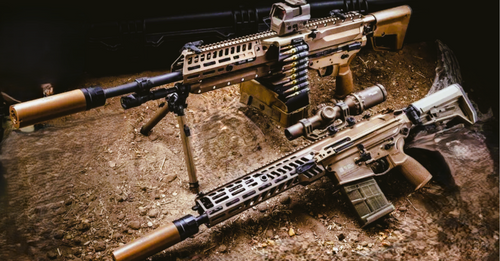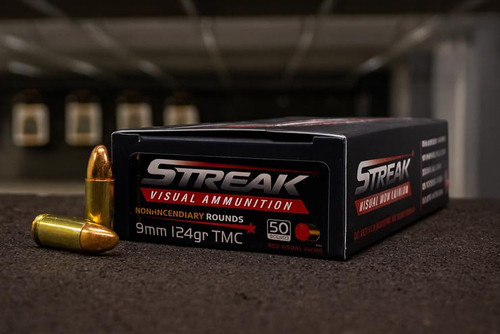Why Did The US Military Choose the 6.8mm?
Introduction
In recent years, the U.S. military has made a significant decision to transition from the traditional 5.56mm and 7.62mm NATO rounds to a new 6.8mm cartridge. This move is part of the Next Generation Squad Weapon (NGSW) program, which aims to modernize the U.S. military's small arms capabilities. The choice of the 6.8mm round is driven by a combination of factors, including the need for improved performance, increased lethality, and enhanced versatility on the modern battlefield. This blog explores the reasoning behind the U.S. military's decision to adopt the 6.8mm round and the implications of this change.
Historical Context: 5.56mm and 7.62mm NATO Rounds
The 5.56mm NATO round has been the standard issue for U.S. military rifles since the 1960s, with the introduction of the M16 rifle during the Vietnam War. This round was chosen for its relatively low recoil, high velocity, and the ability to carry more ammunition due to its lighter weight. These characteristics made it suitable for the rapid-fire engagements typical of modern infantry combat.
On the other hand, the 7.62mm NATO round, which was introduced in the 1950s, has been used in various roles, including machine guns and designated marksman rifles. Known for its stopping power and long-range capabilities, the 7.62mm round excels in penetrating barriers and delivering lethal force at extended distances.
Limitations of Existing Rounds
Despite their strengths, both the 5.56mm and 7.62mm rounds have limitations that have become more apparent in recent conflicts. The 5.56mm round, while effective in certain scenarios, often struggles with range and lethality, particularly against adversaries wearing modern body armor. Its lightweight nature, while advantageous for carrying more ammunition, reduces its ability to deliver consistent stopping power at longer ranges.
The 7.62mm round, while powerful, is heavier and generates more recoil, which can be challenging for soldiers to manage during sustained engagements. Additionally, its weight limits the amount of ammunition a soldier can carry, potentially reducing their overall combat effectiveness. These limitations have driven the need for a more versatile and effective cartridge to combine the attributes of both 5.56 and 7.62x51mm.
Development of the 6.8mm Round
The development of the 6.8mm round is a response to the evolving requirements of modern warfare. The U.S. military's NGSW program aimed to create a cartridge that would bridge the gap between the 5.56mm and 7.62mm rounds, offering improved performance in terms of range, lethality, and barrier penetration. The result is the 6.8mm round, designed to address the shortcomings of its predecessors while incorporating advanced materials and engineering techniques.
Enhanced Performance
One of the primary reasons for choosing the 6.8mm round is its enhanced performance characteristics. The 6.8mm round is designed to deliver greater energy on target compared to the 5.56mm round, significantly improving its lethality. This increased energy translates to better performance against adversaries wearing body armor, a growing concern in modern combat scenarios.
Furthermore, the 6.8mm round offers improved accuracy and range compared to the 5.56mm round. This enhanced range capability allows soldiers to engage targets effectively at longer distances, reducing the risk of enemy counterattacks and increasing overall battlefield effectiveness.
Versatility and Adaptability
The 6.8mm round is designed to be versatile and adaptable to various combat scenarios. It provides a balance between the lightweight nature of the 5.56mm round and the stopping power of the 7.62mm round. This versatility makes it suitable for a wide range of roles, from standard infantry rifles to squad automatic weapons and designated marksman rifles.
The adaptability of the 6.8mm round also extends to its use in different environments. Whether in urban settings, open fields, or dense forests, the 6.8mm round is engineered to perform consistently, providing soldiers with a reliable and effective cartridge regardless of the operational context.
Technological Advancements
The development of the 6.8mm round is also driven by advancements in materials and manufacturing techniques. Modern metallurgy and propellant technology have enabled the creation of a cartridge that offers superior performance without significantly increasing weight or recoil. These advancements ensure that the 6.8mm round can deliver the desired performance characteristics while maintaining manageable recoil for soldiers in combat.
Improved Barrier Penetration
Another critical factor in the decision to adopt the 6.8mm round is its improved barrier penetration capabilities. In modern combat, soldiers often encounter a variety of obstacles, from walls and vehicles to body armor. The 6.8mm round is designed to penetrate these barriers more effectively than the 5.56mm round, ensuring that soldiers can engage and neutralize threats with greater confidence and efficiency.
Logistics and Supply Chain Considerations
The transition to the 6.8mm round also involves logistical considerations. While the introduction of a new caliber requires adjustments to the supply chain and ammunition storage, the benefits of the 6.8mm round's performance outweigh these challenges. The U.S. military has invested in ensuring a smooth transition, with efforts to standardize and streamline the production and distribution of the new cartridge.
Future-Proofing Military Capabilities
The adoption of the 6.8mm round is also a strategic move to future-proof the U.S. military's small arms capabilities. As military technology and tactics continue to evolve, the need for more versatile and effective ammunition will only grow. The 6.8mm round provides a foundation for further advancements in small arms technology, ensuring that the U.S. military remains at the forefront of combat effectiveness and innovation.
Training and Integration
Integrating the 6.8mm round into the U.S. military's arsenal also involves significant training and adaptation efforts. Soldiers must become proficient with the new ammunition and the weapons designed to fire it. This transition period is crucial to ensure that troops can fully leverage the advantages of the 6.8mm round in various combat scenarios. Training programs are being updated to include instruction on the handling, maintenance, and tactical use of the new round and associated weapon systems. The transition to the new round, supported by advanced technology, training, and strategic considerations, reflects a commitment to ensuring that U.S. troops are equipped with the best possible tools to succeed in their missions.
Comparison with Other Calibers
The 6.8mm round was selected over other potential calibers due to its superior balance of performance characteristics. While there were other contenders, the 6.8mm round demonstrated the best combination of range, accuracy, lethality, and barrier penetration during testing. This comprehensive evaluation process ensured that the chosen caliber would meet the diverse needs of modern military operations.
Environmental and Operational Benefits
The environmental conditions of modern battlefields are varied and challenging. The 6.8mm round is designed to perform reliably in a wide range of temperatures and weather conditions. Its robust construction and advanced materials help ensure consistent performance, whether in arctic cold, desert heat, or humid jungle environments. This reliability is critical for maintaining combat readiness and effectiveness in any theater of operations.
Feedback from the Field
Feedback from soldiers in the field has been a vital component of the decision to adopt the 6.8mm round. Troops who have tested the new ammunition have reported improved performance, particularly in terms of stopping power and range. These firsthand accounts have reinforced the decision to transition to the 6.8mm round, providing practical insights into its benefits and confirming its suitability for modern combat.
Strategic and Tactical Advantages
The transition to the 6.8mm round also provides strategic and tactical advantages. Enhanced lethality and range capabilities allow for more effective engagement of enemy forces, potentially reducing the duration and intensity of firefights. This increased effectiveness can lead to quicker resolutions of combat situations, saving lives and resources. Additionally, the improved barrier penetration capabilities provide a tactical edge in urban warfare, where enemies often use cover to their advantage.
Cost Considerations
While the development and implementation of a new caliber involve significant costs, the long-term benefits justify the investment. The enhanced performance and versatility of the 6.8mm round are expected to improve overall combat effectiveness, potentially leading to reduced casualties and more successful missions. These outcomes can offset the initial costs by enhancing the U.S. military's operational efficiency and effectiveness.
Allied Forces and Standardization
The adoption of the 6.8mm round also has implications for allied forces and standardization. NATO allies, who have traditionally used the 5.56mm and 7.62mm rounds, may consider transitioning to the new caliber to maintain interoperability with U.S. forces. This standardization can enhance joint operations and improve logistical coordination among allied militaries, strengthening overall coalition capabilities in a combat environment.
Conclusion
The U.S. military's decision to adopt the 6.8mm round to replace the 5.56mm and 7.62mm NATO rounds marks a significant shift in small arms capabilities. Driven by the need for improved performance, increased lethality, and enhanced versatility, the 6.8mm round addresses the limitations of its predecessors and offers a future-proof solution for modern combat. With its superior range, accuracy, barrier penetration, and adaptability, the 6.8mm round positions the U.S. military to maintain its edge on the battlefield and continue to protect and defend national interests effectively. Additionally, its versatility, compatibility with existing platforms, advanced ballistic performance, and integration with next-generation weapon systems make it a superior choice for modern combat and finding a balance between the two most proven calibers in military use.




 Kyle Lewis
Kyle Lewis

















































